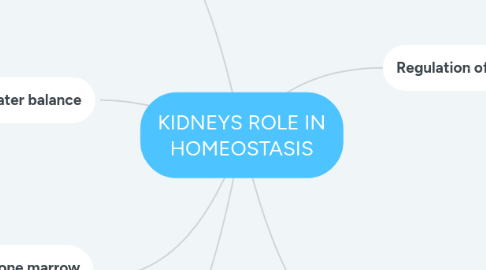
1. Regulation of blood pressure
1.1. The Renin-Angiotensin system or RAS regulates blood pressure and fluid balance in the body.When blood volume or sodium level in the body are low or blood potassium is high ,then the kidney cells release the enzyme renin.
1.1.1. Renin converts angitensinogen,which is produced by liver to the hormone angiotensin 1 -Angiotensin converting enzyme from lungs metabolizes angiotensin 1 to angiotensin 2-Angiotensin 2 cause blood vessels to constrict and blood pressure increases .which also stimulate release of aldosterone in adrenal gland and cause renal tubules to retain sodium and water and excreate potassium.If renin- angiotensin system becomes overactive ,consistently high blood pressure results.
1.1.1.1. Loss of blood pressure control can lead to Kidney Failure.Uncontrolled hypertension can cause arteries around the kidneys to narrow ,weeken or harden. Damged kidney arteries donot filter well and damaged kidney fail to control blood pressure.
2. Regulation of water balance
2.1. Hypothalamus of Brain stimulates pitutary gland of endocrine system.ADH secreated by posterior pitutary helps regulates blood volume by increasing permiability of distal convoluted tuble and collecting duct so that water may be reabsorbed.When there is a rise in plasma osmolarity ,water is reabsorbed into the blood ,diluting the plasma and reducing osmolarity to normal.A fall in plasma osmolarity leads to decrease in ADH secreation by negative feed back.
2.1.1. Aldosterone -hormone secreated from adrenal cortex of the kidneyand effecte the distal tubule .Secretion of aldosterone is regulated by peptide and angiotensin 2. When more aldosterone is secreated ,the more sodium is reabsorbed and water is reabsorbed.Atrial natriuretic peptide(ANP) is released by atrial cells in response to stretch in atrium from fluid overload.ANP inhibits RAAS to reduce the fluid volume by excreating sodium and water.
2.1.1.1. Disturbance in this regulatory mechanism can lead to excess fluid volume or hyponatremia or hypernatremia.
2.1.1.1.1. Hypernatremia- is a form of dehydration. signgs and symptoms are headache, dizzyness,edema,lethargy,thirst,fever and seizure. severe cases may lead to coma and eventualy death.
2.1.1.1.2. Hyponatremia-Replacing fluid losses with electrolyte for water in diseases lead to hyponatremia due to dilution. Signs and syptoms are stuper/coma,anorexia,lethargy,muscle weakness,orthostatic hypotension,seizure,headache,stomach cramping.
3. Regulation of elctrolytes balance
3.1. The kidneys help maintain eectrolyte concentration by filtering electrolyte and water from blood , returning some to the blood and excreting any excess into the urine. Thus the kidneys help maintain a balance between daily consumption and excreation of electrolyte and water.
3.1.1. Regulation of sodium and potassium-Sodium is reabsorbed from the renal filtrate and potassium is excreted into the fiiltrate in the renal collecting tubule.The control of this exchange is governed principaly by Aldosterone and Angiotensin 2.Alteration in thisa function can lead to Hypokalemia or Hyperkalemia.
3.1.1.1. Hypokalemia:_ signs and symptoms include constipation,ileus,weakness,lethargy,depressed reflexes, arrhythmias, and arrest
3.1.1.2. Hyperkalemia;- Signs and symptoms include nauseaa,vomiting,diaarrhea,arrythmias,paralysis,respiratory failure.
3.1.2. Regulation of calcium and phophate - Calcium and phosphate are both regulated through actions of three hormones- parathyroid hormone (PTH),dihydroxyvitamin D (calcitrol),calcitonin.All these are released or synthezised in response to the blood levels of calcium.Alteration of this function may lead to hypo or hyper calcemia and hypo or hyperphosphatemia.
3.1.2.1. Hypercalcemia; - Signs and symptoms include depression , weak muscles,flank pain,calcium stones in kidney,thinning of bones,deep pain over bony area,signs of heartattack.
3.1.2.2. Hypocalcemia:- signs and symptoms include anxiety,irritability,numbness, tingling,muscle twitching,convulsions,abdominal muscle cramps,ECG shows lenthened STsegment and prolonged QT interval.
3.1.2.3. Hypophosphatemia:- signs and symptoms include respiratory failure,numbness,confusion,convulsion,irritability,coma.
3.1.2.4. Hyperphosphatemia:- increased pulse,nause and vomiting,weakness,anorexia.
4. Regulation of bone marrow production
4.1. When there is hypoxia the kidneys secreate erythropoetin which stimulates the production of red blood cells.Severe anemia develops as a reduction of erythropoetin production.
4.1.1. Anemia:-Signs and symptoms include fatigue,weakness,headache,SOB,chets pain,dizzyness,irregular heart beat,increased rest requirements.
4.1.1.1. Interventions
4.1.1.1.1. Provide oxygen therapy if needed,educate patients about medications that may stimulate RBC production in bone marrow,instuct the patient about bleeding precautions,moniot stool for occult blood and unine for hematuria, assess for any frank bleeding from nose,gums,vagina or GItract.
5. Regulation of blood PH
5.1. Kidneys maintain acid base balance by reabsorbing bicarbonate from urine and excreating hydrogen ions into urine. This process primarly occur in proximal tubule,distal tubule and collecting duct by bicarbonate (H2O+CO2<_>H2CO3<_>H+HCO3-) Phophate (HPO4+ H<->H2 PO4) and ammonia (NH3+ H+<->NH4+) buffer system.Acid urine is formed if PH of the body fluid is in the acid range ,then the kidneys excrete more H+than HCO3- .Alcaline urine is formed if the PHof body fluid is in the alkaline range.Then the kidneys excrete more HCO3 than H+.
5.1.1. Imbalance of this function lead to Metabolic acidosis:- A condition that occurs when the body produces excessive quantities of acid or when the kidneys are not moving enough acid from the body.
5.1.1.1. Signs and symptoms are chest pain,palpitation,headache,altered mental status,nausea,vomiting,abdominal pain,weight gain,muscle weakness,increased respiratory rate and depth.
6. Regulation of waste removal
6.1. Kidneys excrete waste by filtering blood and producing urine .Excess ions,sodium,potassium,calcium,magnesium,chloride ,bicarbonate, phosphate and ammonia,metabolic waste such as urea,creatinine,uric acid ,nitrogenous waste and drug metabolites are excreted from the body through the kidney.
6.1.1. Unable to excrete waste products will lead to uraemia or azotemia.
6.1.1.1. Uremia means urine in the blood.When the kidney function is altered,kidneys are unable to remove urea and uric acid formed as a result of protein breakdown,there is presence of urea in blood.Signs and symptoms arenausea ,decreased appetite,weight loss,high blood pressure,anemia,cramps,dry itchy skin.
6.1.1.1.1. Azotemia is defined as nitrogen in blood.Signs and symptoms include thirst,edema,confusion,dry mouth.
